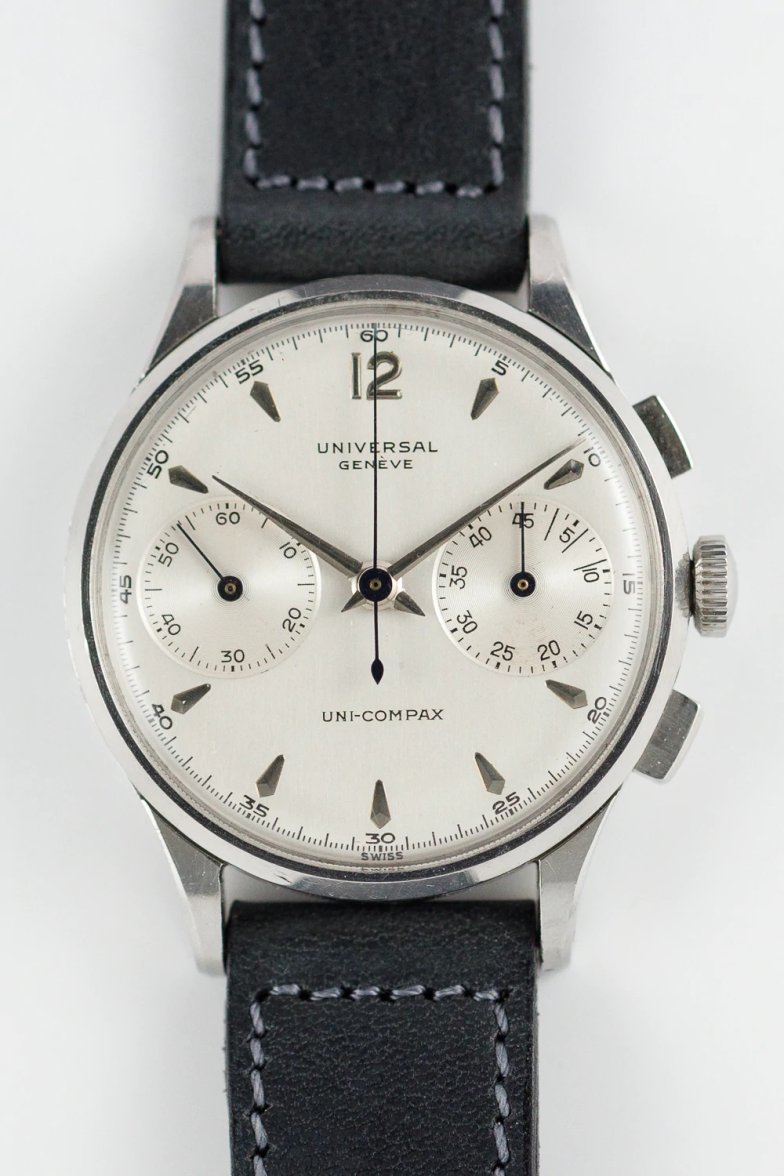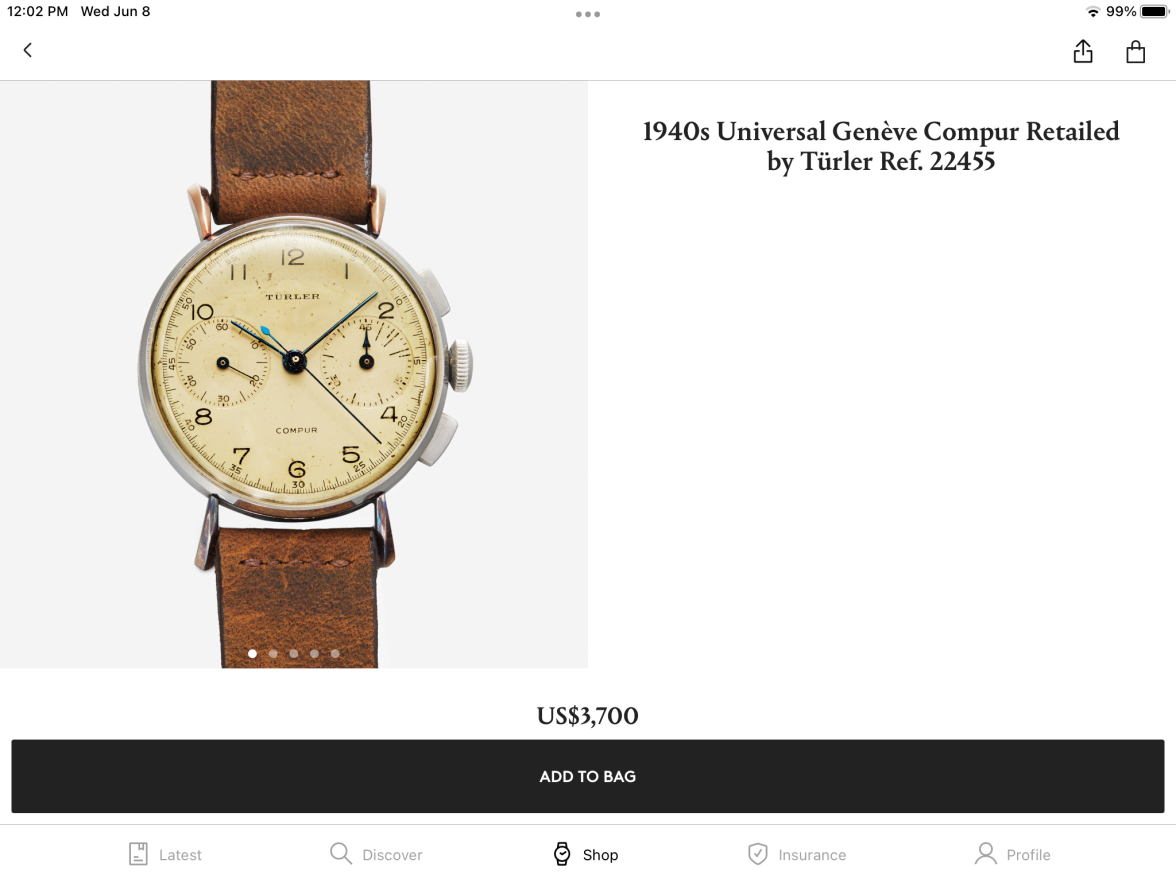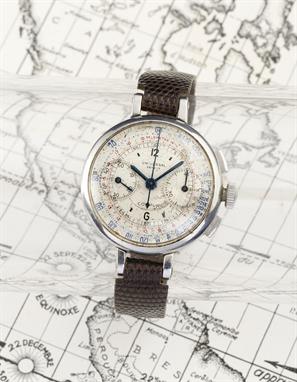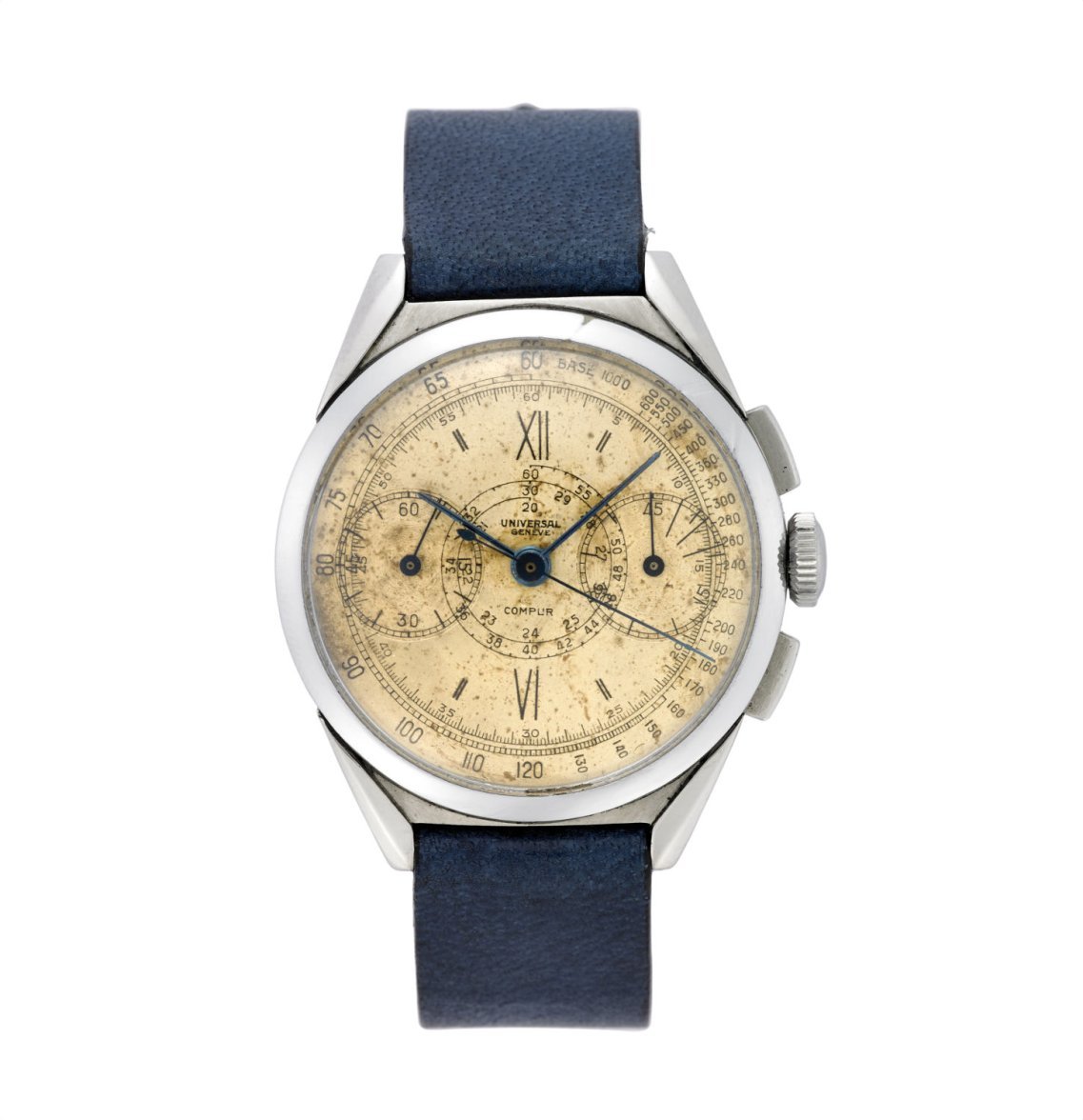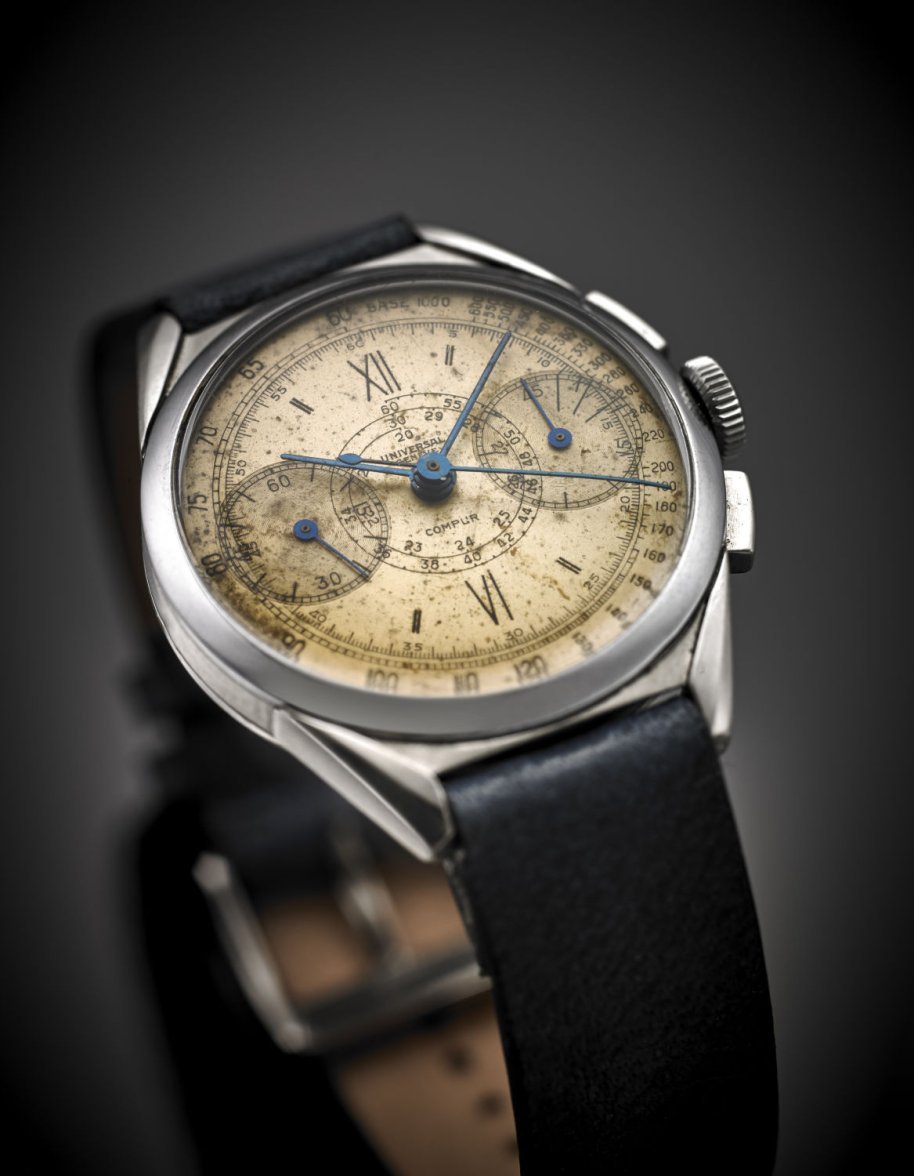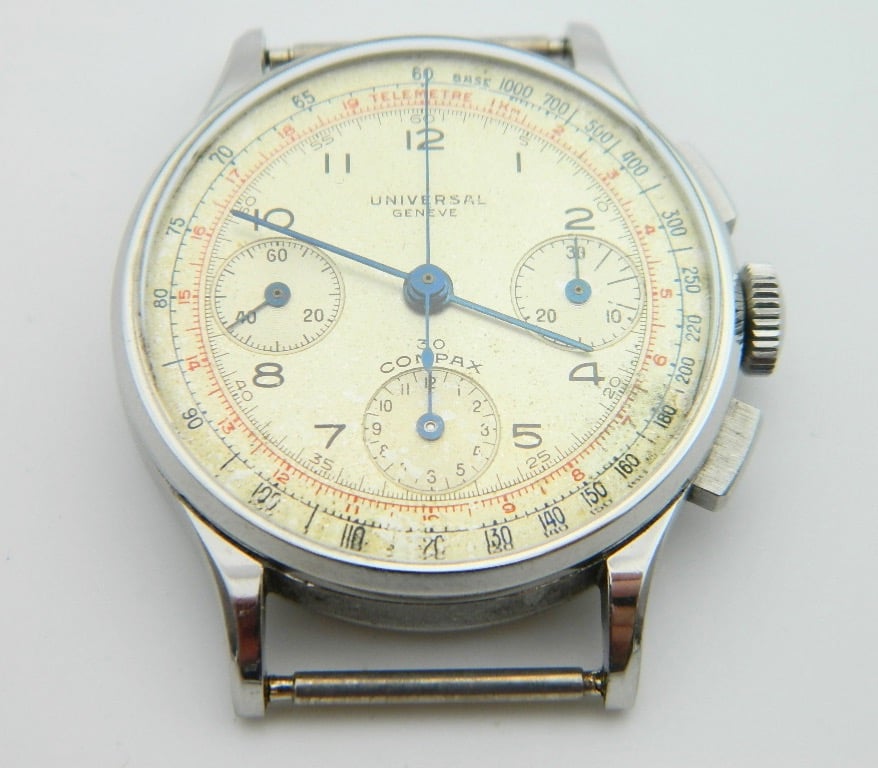Interesting write up in the description anyway:
Ultra rare and vintage 1st Series of Universal Genève Compur from 1930 carrying the famous 285 Caliber steel case and steel bracelet.
A little background about this ultra-rare Universal Compur 1st series and some useful curiosity...
On 9 June 1934, at 1 pm, the “Universal Watch Compur” trademark, with the number 83024, was filed by “Perret & Berthoud S.A.” (1, 2).
The “Universal Watch Compur” trademark, registered under number 83024, on June 9, 1934, at 1 pm.
On the same day, the “Compur” trademark is also registered, with the number 83340 (2, 3).
A little less than a year earlier, and precisely on 12 August 1933, Georges Ulysse Perret, one of the founders of the company, had disappeared, first together with Numa-Emile Descombes in 1894, and, subsequently, after the untimely death of the latter, together with Louis-Edouard Berthoud, in 1897 (2, 3).
It was therefore decided, in 1934, to start production of the "Compur" model which represents for the company the first development of a multifunction chronograph with two operating buttons and which follows the Breitling two-button chronograph, the first in history , which went into production a few months earlier, on the basis of the patent of 6 October 1933, n ° CH172129.
The internal caseback of the Universal Watch "Compur": note the gold title in carats and in thousandths, the "Elvetia" hallmark, the Universal Watch brand, the brand of the case manufacturer (166 = Henri Jeanneret-Peseux, Le Locle), and the serial number (1, 5). It seems that the production of these models lasted only for one or two years, with serial numbers between 551000 and 562.000.
It is actually a single-button chronograph to which is added the possibility of measuring intermediate times when the chronograph is started, with stop and restart without returning to zero, by means of a button at 4 o'clock, while the button at 2 o'clock keeps the functions " start-stop-reset "(or" start-stop-reset "), typical of single-button chronographs.
The column wheel, in fact, is the typical one of the single-button chronograph, with 6 columns and a spool with 18 saw teeth: it, therefore, has a column every three teeth (6).
The large lever, activated by the button at 2 o'clock, by acting on the ratchet, each time the button is pressed, makes the column wheel rotate clockwise by one tooth (by one step); the beak of the return receiver, therefore, descends from a column to cause the central wheel of the chronograph to start; when the button is pressed again at 2 o'clock, it goes up again, causing it to stop, but once it gets up, when the button is pressed for the third time to reset, the spout of the return rocker remains on the column itself in order to keep the central wheel of the chronograph with the reference wheel, allowing, during the reset, the central wheel of the chronograph to be free to rotate by the action of the reset lever (or hammer).
It is interesting to note that the 14 ½ "’ Universal chronograph calibers were equipped with a Breguet hairspring, in which the python is closer to the axis of the balance wheel than is observed in the flat hairspring, allowing them to be easily recognized (7).
The additional function of measuring intermediate times when the chronograph is started is made possible by adopting a "second column wheel", the spool of which is visible from the dial side (2).
Although this mechanical peculiarity was already described years ago by several authors (I recall, among others, the web page of the history of the Manufacture, Antiquorum, the authors Italor Bonifacio with Laura Rivolta, and Marco Strazzi) (1, 8, 9, 10), the merit of having demonstrated the presence of this characteristic, on which the attention of enthusiasts has focused, with renewed interest (11, 12, 13), goes to Pietro Giuliano Sala, with the publication of the monographic text dedicated to Universal watches (2).
The "sawtooth" spool of the "second column wheel" is visible, as already mentioned, from the dial side, while the columns of the "second column wheel" are barely distinguishable in a hole in the plate near the receiver of the idler wheel, interacting with the latter.
The button at 4 o'clock is articulated with a lever placed in the space between the movement itself and the dial, which causes the "second column wheel" to rotate by a small angle counter-clockwise, assisted by a clip that acts on the “sawtooth” grooves; this receiver has columns, visible from the back side, which lift and rotate the reference receiver anti-clockwise, moving it away from the "main" column wheel and interrupting the connection between the reference wheel and the central chronograph wheel: in this way the central hand of the chronograph stops when the chronograph has already started using the button located at 2 o'clock.
A subsequent pressure of the button at 4 o'clock causes the reference rocker to lower and rotate clockwise, approaching the column wheel, restoring the connection between the reference wheel and the central chronograph wheel; the central hand of the chronograph then restarts from the position in which it stopped previously.
As we have already said for the "Contax" and "Aero-compax" (14) models, most likely, the conception, design and production of the Universal Watch "Compur" caliber were, in reality, the work of of the "Martel Watch", and it is likely that "... at least until 1941, the year in which the Universal bought the" Martel Watch ", the Universal used movements that were not designed and produced" in house ", but by the" Martel Watch ”and that, therefore, the“ Universal Watch ”was not a“ manufacture ”, but rather a simple" établisseur "(assembler).
This result that, perhaps, will make many fans of the history of watchmaking and of this historic brand jump on their seats ...

